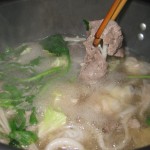I’m not a world class chef, but I can microwave a mean Banquet Salisbury Steak TV dinner.  So, anytime there’s some tips on improving my kitchen game, I’m all ears. Check out this video from thekitchn where they discuss basic knife skills for any kitchen newbies.
How To Learn Basic Knife Skills from Apartment Therapy: The Kitchn on Vimeo.
What You Need
Materials
Onion or another vegetable for practicing
Equipment
Cutting board
Rubber mat or other stabilizing material
Sharp chef’s knife
Instructions
1. Stabilize your cutting surface - Before you even get started with your knife, stabilize your cutting board to keep it from slipping or moving. Place a piece of nonskid rubber material underneath. You can also use an old placemat, or a damp dishtowel.
2. Choose a sharp knife that feels comfortable - Choosing a good knife is important! It’s difficult to give precise instructions on that here, as it will be different for everyone. It will depend on the shape and and size of your hands, and your own cooking style. Go to a cookware or knife shop and hold a lot of different kinds of knives. Look for one that feels heavy enough to be substantial, but not so heavy it drags your wrist down. Finding the best knife will take time and experience, and until you have your “perfect knife” just make sure the one you’re working with is sharp and in good condition.
3. Learn how to hold the knife - The knife should be gripped securely around the handle, and ideally you should be able to pinch the bottom end of the blade with your thumb and forefinger. (If this is difficult, this may be a sign that the knife is not the right shape or size for your hands.) Do not extend your forefinger along the top of the blade, as this will decrease your control and speed. When you are holding the knife correctly you will find that you tend to use your upper arm and shoulder more to support the weight and to control the motion of the knife — as opposed to your wrist and forearm.
4. Create a stable surface on your vegetable - The first order of business when chopping an onion (or any other vegetable) is creating a stable surface from which to work. This almost goes without saying; it’s second nature to most cooks! But it’s helpful to think about it purposefully and to look over a vegetable before chopping to determine the right stable surface to create. On an onion, for instance, you should trim off both ends, then cut the onion in half lengthwise. Then you have a stable, flat surface from which you can do more fine chopping.
5. Practice The Claw - Now that you’re holding your knife correctly, your other hand should be forming The Claw while chopping. Curl your fingers back into a claw while holding the vegetable you’re chopping so that if your knife slips you just hit your knuckles instead of actually cutting your fingertips.
Additional Notes:
• These are just the most basic elements of well-formed knife skills. If you practice these consistently, you will find that you have more control and more speed when working with your knife.
• There are of course many other specialized knife skills developed by various cuisines for a variety of foods (dicing, mincing, boning) but these skills here are just the basics to get you started.
thekitchn
you might also like...
